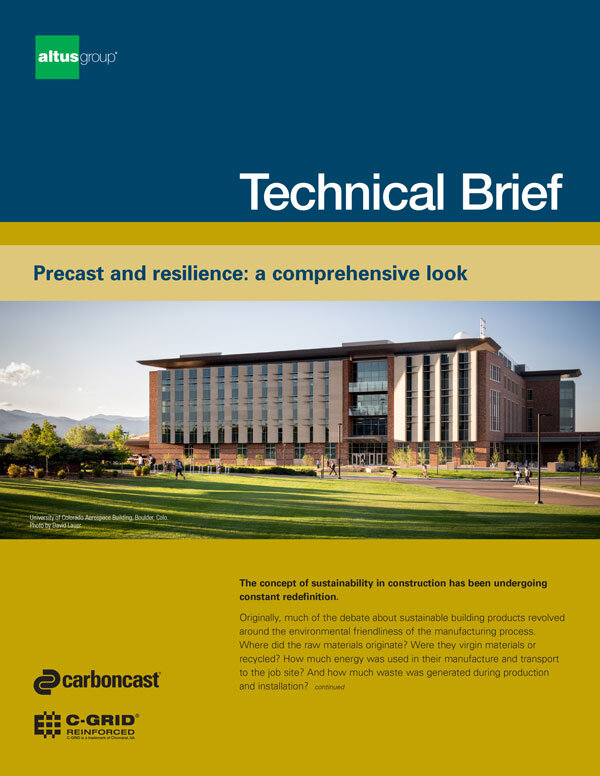Image courtesy of PCI Northeast.
Due to the many benefits it can bring to a project, offsite construction continues to grow in popularity within the construction industry.
Offsite construction is defined as any part of the building process that is completed away from the jobsite and includes both prefabrication and modular construction. Precast is designed and poured in precast plants where the components are overseen by precast manufacturers who adhere to strict quality review processes to ensure quality projects are created prior to arrival at the jobsite.
ERECTION IN TIGHT OR URBAN SPACES
With the pre-planning that goes into the use of precast concrete, site access and crane placement are determined long before precast components arrive on site. Our dedicated team of Project Managers and Field Installers have been on hundreds of jobsites with varying conditions and utilize their expertise and years of training to come up with the best plan for a successful project. Additionally, since precast concrete is manufactured offsite and shipped to jobsites and installed as needed, space is not needed for storage or manufacturing onsite.
Mid-States Concrete Industries is an S2 PCI-Certified Erector. Our S2 rating certifies us to install both complex and simple structural systems. Simple structural systems include horizontal decking members (such as hollow core slabs on walls) and single-lift wall panels attached to a structure. Complex structural systems include total precast concrete systems, multi-product structures (those that combine vertical and horizontal members), and single- or multistory-loadbearing members, including those with architectural finishes.
MANUFACTURED IN QUALITY CONTROLLED ENVIRONMENT
Quality can be improved with offsite construction because components are manufactured in environments that operate under strict quality guidelines. PCI has developed strict quality standards that all PCI-Certified Plants are required to follow in order to retain their certifications.
Mid-States Concrete Industries is AC, B3, and C3 certified to produce architectural precast, beams, columns, hollow core slabs, solid slabs, and structural wall panels.
Our AC rating certifies us in the production of architectural precast concrete products including cladding or non-load bearing products with architectural finishes such as plant applied finishes formliners, brick veneers or extruded profiles, as well as structural products with an architectural finish.
Our B3 rating certifies us in the production of all precast, prestressed superstructure elements using straight, pretensioning, or posttensioning strands, as well as mild steel-reinforced precast concrete elements.
Our C3 rating certifies us in the production of precast concrete structural members that are prestressed with straight, pretensioning, or posttensioning strands such as stemmed members for roofs, floors, and walls, as well as beams, columns, spandrels, joists, and seating members, as well as wall construction that may be wet cast, machine cast, extruded or slip formed, and conventionally reinforced precast concrete elements.
TECHNOLOGY HAS ADDED SPEED AND ACCURACY
Technology has advanced the industry by helping increase speed and accuracy in construction.
Mid-States Concrete Industries uses Revit, a design software for Building Information Modeling used extensively by architectural and engineering firms. Its variety of tools let designers use the intelligent model-based process to plan, design, construct, and manage buildings and infrastructure. Use of Revit allows for easy project model sharing and coordination with customers.
REDUCES THE NUMBER OF PERSONNEL IN THE FIELD
Precast concrete also allows for less personnel on the jobsite. Less people equals less risk of injury and/or accidents. Oftentimes, precast allows for the quicker installation of a building’s shell, allowing other trades to get onsite even sooner.
Safety is a big deal to Mid-States Concrete Industries. The South Beloit Plant achieved SHARP (Safety & Health Achievement Recognition Program) certification in 2017 and has maintained it since. SHARP recognizes small business employers who have used OSHA’s On-Site Consultation Program services and operate exemplary safety and health programs. Acceptance of a worksite into SHARP from OSHA is an achievement of status that singles a company out among its peers as a model for worksite safety and health.
Source: PCI, PCI Gulf South, and PCI Northeast





